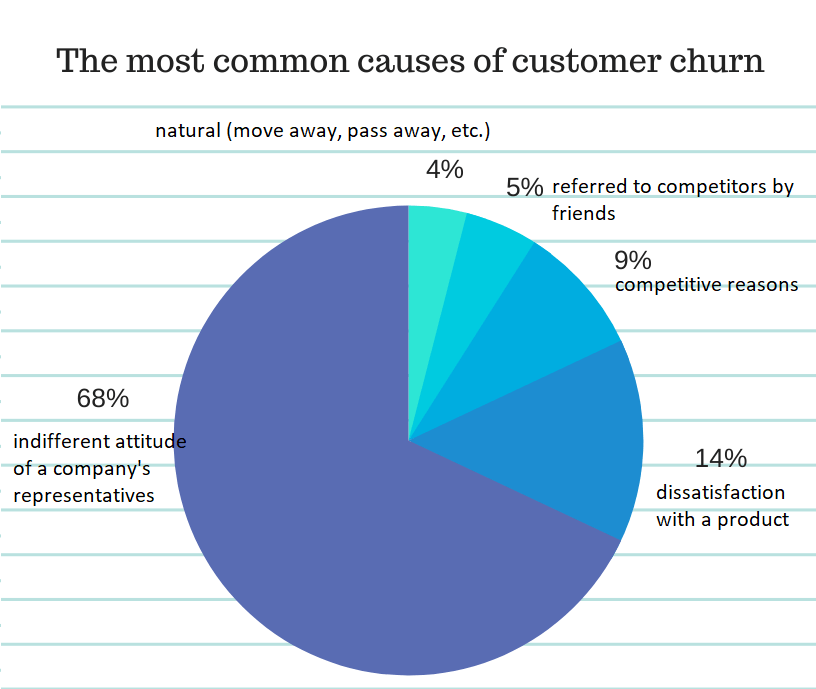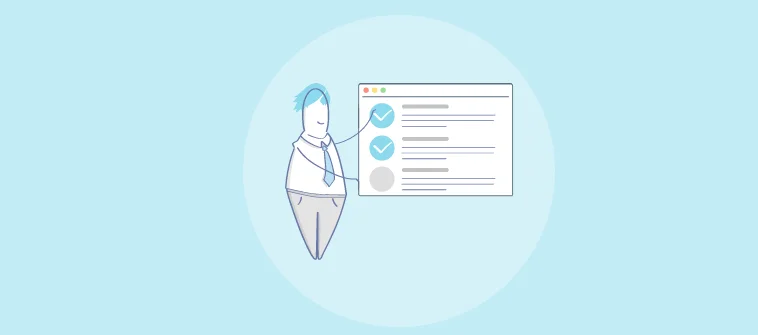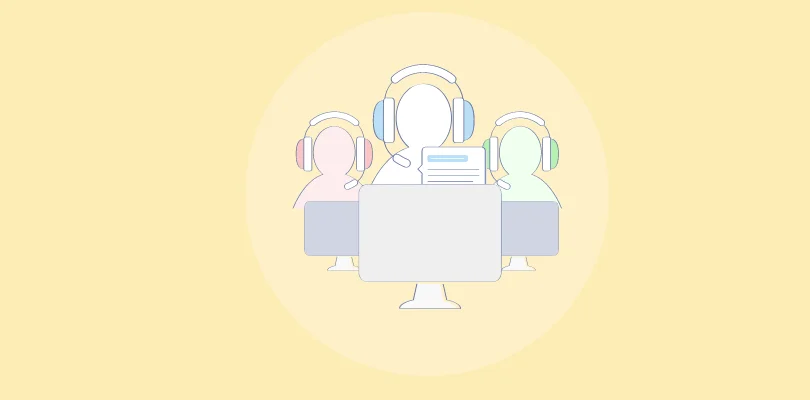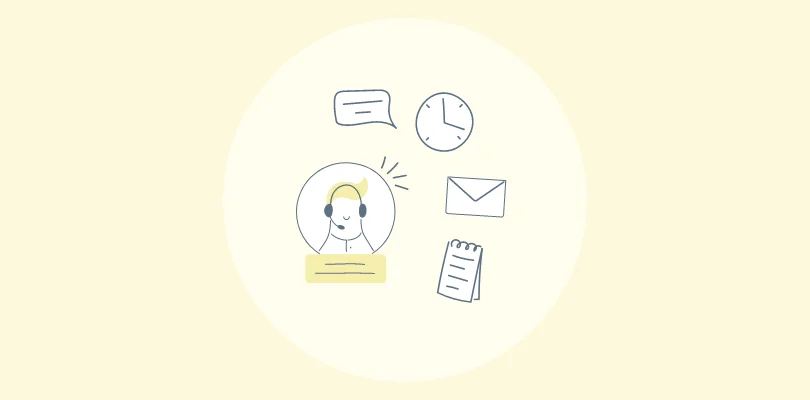
I bet you’ll agree with me on this one:
Customers stop doing business with you when they are unhappy. In fact, 68% of customers leave because they believe you don’t care about them. More than that, only 1 in 26 unhappy customers will complain about what they don’t like about your service; the rest will churn.
And that’s the problem.
The more customers leave, the less your business grows. With customer retention being the primary driver of companies’ revenue, churn lowers your profits by far. And given that acquiring new customers costs a company five times more than retaining existing ones, it’s worth thinking about the strategy for preventing customer churn, agree?
In this article, we take a look at the nature and reasons for customer churn and reveal some strategies on how your customer service can help to solve churn problems.
What Is the Customer Churn?
Customer churn refers to the percentage of your clients or subscribers that ended the use of your products or services and, therefore, stopped bringing revenue to your business. It’s also known as customer attrition and is typically calculated over a pre-determined period.
How to calculate the customer churn? Divide the lost customers by the number of customers you started the period with.

Let’s say you started the quarter with 1,000 customers and lost 100. Your churn rate will be (100/1000)x 100 = 10%.
Or, feel free to use numbers instead of percentages to calculate your customer churn. The alternative ways to figure it are by the number of customers lost and by monitoring your sales performance and calculating the percentage of MMR (monthly recurring revenue) lost.
Reasons for the Customer Churn
As mentioned above, 68% of consumers leave you because of perceived indifference. And while you believe you have excellent customer service, only 8% of your customers would agree. Such a considerable delivery gap leads to misunderstanding and lack of information for business owners on what they need to change for better customer service.

Source, the chart made with Canva
Other reasons for churn include:
- Price: A customer finds a more cost-effective solution and goes to your competitors.
- Poor product: A customer purchases your product, tries it for a couple of months, and understands that it doesn’t fit their expectations and can’t help them solve a problem.
- Negative user experience: A customer sees that it’s uncomfortable to work with you (your software is buggy, it’s challenging to use your service, etc.)
- Poor customer experience: A customer connects with all the aspects of your brand — content, managers, social media, customer support — and doesn’t like it. They don’t feel welcomed; they experience negative emotions when interacting with your company, so they leave.
That’s all great, but why do so many customers feel our brands are unconcerned with them?
The reasons vary, but most relate to lousy customer service: unanswered complaints, long response time via phone calls or live chats, inconsistent follow-ups, indifferent or even rude customer support representatives speaking like robots, and so on.
The good news is that all this is within your control, and you can reduce the customer churn drastically by prioritizing your helpdesk and overall service to make your customers happy.
How Customer Service Helps to Solve Churn Problems
So, the majority of customers leave because of dissatisfaction with your service. At the same time, 86% of them are ready to pay more for better customer experience. That said, excellent customer service reduces churn and helps your business charge and earn more.
Here’s what you can do to solve churn problems:
? Enable Successful Onboarding
The moment you onboard a customer is the most critical: While they bring you some revenue by a mere sign-up, they’ll be more likely to churn if they don’t experience a “win” after that. Once a customer signs up, make sure your support team takes a proactive role to help him see the value of your product or service.
It’s the moment when you lay the foundation for productive and loyal relations with your customers.
Message a new customer on the first day of onboarding to start communication and let him know you’ll be here to help at any time. Therefore you’ll promote engagement and make customers feel that they’ve made the right choice and are valued.
? Make Sure to Support Across the Board
Excellent customer service is not about the helpdesk and answering calls only. What you need to do is build resources around your support team so that customers could find all the information and get the answers to their questions as soon as possible.
In other words, your customer service should appear at every touchpoint.
As a responsible marketer or business owner, you know your buying persona inside out. Where do your customers spend time online? Do they prefer to find answers at your FAQ page or ask your chatbot on the website or in social media messengers? What you need to do is allocate all the resources to help your customers.
- Invest in building help content so customers could find answers to their questions there: blog articles, FAQ pages, tutorials, tips on social media, etc.
- Create a chatbot so customers could save time on reading and get answers to their questions faster. Installing chatbot, make sure to write a smart scenario for it. For that, cover as many situations as possible, think of a chatbot’s personality and tone of voice it will use, and make it intelligent enough to avoid the most common grammar mistakes influencing customer perception and trust.
- Train your support team representatives to communicate with customers in live chats so they could offer real-time service and address multiple queries at once. In fact, live chats help to build long-term customer relationships: 73% of customers believe that friendly customer support makes them fall in love with a brand.
- Help your service team develop and grow skills for more effective communication with customers: empathy, patience, clarity in conversation, attentiveness, humility — all they influence customer retention by far, allowing customers to feel loved and valued.
- Remember about email communication. Your customer service emails should be well-crafted and professional enough to turn an angry customer into a happy one.
? Do Your Best to Match Their Expectations
Customer confusion around your product or service leads to churn too. It may happen when their needs don’t match with what you offer or when they lack support around particular issues. And while you can’t do anything with the former (even the best customer service in the world won’t hold your non-target audience), the latter is within your control.
And here is where your customer service can help too: Use it to determine mismatches in customer expectations and address them timely to prevent churn.
Your support team has access to customer feedback, so they can help to identify the issues that mismatch customer expectations and share them with marketing, product, sales, or engineering departments. In other words, you can use customer feedback for optimizing your product and service.
Professional support can help you identify where customers need the most help, what part of a customer journey causes the most confusion, and what’s wrong with your product/service or its particular features.
So, ask your customers for feedback in surveys, emails, or feedback forms often; let them know you listen to them and value their inputs; and be ready to change for their needs.
Now that you’ve got the power of excellent customer service from dealing with churn problems, you can start working on your helpdesk and overall assistance to make your customers happy. Use this blog post as a guide to help you shape development, and feel free to share your experience in the comments if we’ve missed anything.
FREE. All Features. FOREVER!
Try our Forever FREE account with all premium features!







